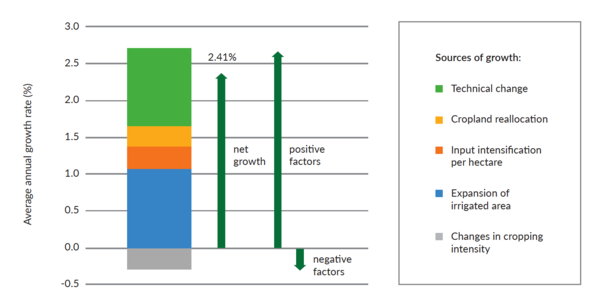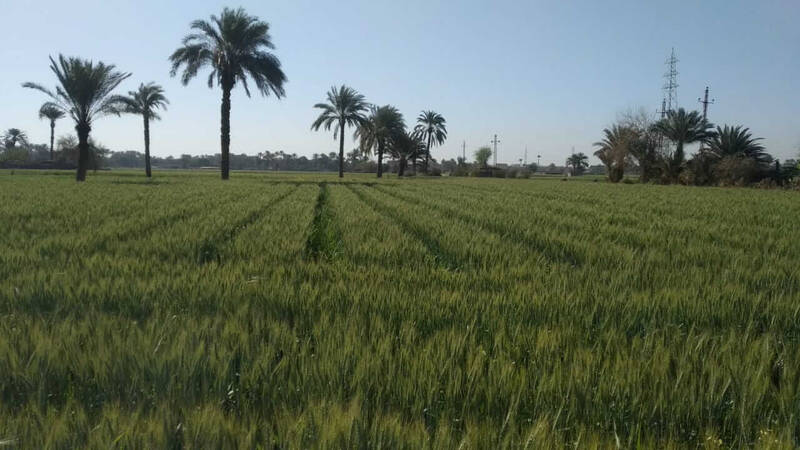World Population Day And The Case for Agricultural Research-For-Development

It may appear logical that the rate of a country’s consumption of agricultural resources is directly proportional to its rate of population growth. But a recent ICARDA study shows the inaccuracy of this assumption. Keeping this in mind, along with climate change, pandemics, and growing populations, unless countries properly invest in studies to assess their agricultural resources and potential, and adequately inform policy, there may be grave consequences for their future food security. This could lead to increased hunger and poverty, mass migration, and regional instability, especially in more vulnerable and resource-constrained dry areas such as the MENA region and beyond.
ICARDA, headquartered in the non-tropical drylands for over four decades, recently carried out the study in Egypt, the outcomes of which are relevant across the region and beyond. Egyptian agricultural policy and water use over the last 55 years was assessed in order to identify trends in agricultural production efficiencies and connect these with causal factors such as use of inputs and resources, and which approaches were deployed. The unexpected outcomes illustrate why such studies are vital to adequately inform policy and improve food security
Examining past policy successes
Due to population growth and climate change, in many dryland countries competition for water, a critical input for agricultural production, is expected to increase. Water plays an increasing role in food security and its scarcity poses a significant and growing threat to agricultural production in many parts of the world.
Yet if water scarcity restricts agricultural production, expanding water resources is only one of many options to increase or maintain output; the study shows that investments in agricultural research and innovations, and the subsequent productivity increases, have been releasing constraints to growth in Egypt for many decades.
Referring to official sources such as Egypt’s Central Agency for Public Mobilization and Statistics (CAPMAS), FAO, ILO, the World Bank and the U.S DoA, the study examined the evolution of agricultural and resource productivity in Egypt over 55 years, from 1961 to 2016, covering major epochs in Egyptian agricultural and economic policy.
A conceptual model was developed to analyze the typical paradigm where agricultural growth depends on the supply and allocation of both public and private resources. To do this, we constructed two Tornqvist-Thiel indexes of total productivity. The first index, total factor productivity (TFP) is based on inputs valued at producer prices, in which water is supplied freely and resource rents accrue to the value of irrigated land.
For the second index, total resource productivity (TRP), the cost of public subsidies for irrigation are included as part of the total agricultural inputs contributing to production, and resource rents are used to derive the implicit social value of water. The index also included the social value of water, as well as public subsidies for irrigation as part of the total agricultural inputs contributing to production.
Using growth accounting, the contributions of expanded irrigation, input intensification, and improved factor and productivity to aggregate agricultural growth were isolated. The uniqueness of this study is the incorporation of water as a factor in the social cost of agricultural production in Egypt, a country almost entirely dependent on irrigation for agriculture and characterized by a population whose basic food needs are exponentially increasing.
Unexpectedly, the study found that the rate of agricultural output was disproportionally faster than the expansion of agriculture itself. Crucially, this was due to gains made from technical innovations that significantly improved productivity, and this was during periods when R4D was conducted both into new approaches and in the efficiency of the use of farmland, labor and capital in productivity.
This was further reinforced when looking at figures that showed how technical and efficiency improvements raised total resource productivity, a measure that includes the social value of irrigation water (i.e. social cost of irrigation known as storage and delivery losses of the irrigation system) as an input into farm production.
Other important factors identified were how market and prices incentivize farmers to adopt new technologies, crops and farming practices, to raise productivity, save resources and create an improved ‘more with less’ return on investment. And finally, when the Egyptian economy transitioned from state-run to market-based, farmers were freer to reallocate resources that were previously unassailable, significantly increasing production.
The Case for Agricultural R4D
The study demonstrates that when R4D improves availability of key knowledge and innovation, farmers eagerly, and somewhat logically, adopt new approaches that result in their improved income through producing ‘more with less’. Improvements in productivity were achieved mainly through adoption of new technologies and management practices, as well as by reallocating resources to more profitable commodities, rather than simply because of the use of evermore land and resources.
If this conclusion seems obvious, it has not been acted upon. In recent decades, there has been a worrying decline in funding for R4D from the global research system, resulting in less vital technologies becoming available. The paradox is that while the costs of R4D are recouped through the gains that innovation generates, countries are reluctant to invest, especially during a recent era of global austerity.
Maintaining agricultural growth in Egypt for example requires a robust public investment in an integrated approach of agricultural research and extension, innovation, improved drainage, and rehabilitation of the existing irrigation infrastructure to assure timely water delivery – it is almost certain that the investment will bear fruit.
A clear takeaway is that when production gains stagnated, Egypt boldly broke the status quo by investing in research to release constraints on resources. Today, global population growth and climate change, along with emergence of new pests and diseases, declining services and the COVID-19 pandemic, are worrying factors that the world needs to address urgently, starting by making rural livelihoods more resilient. In other words, allowing global agricultural R4D to stand still is precisely the wrong way to go.
----------------------------------
Boubaker Dhehibi is ICARDA’s Senior Natural Resources Economist




